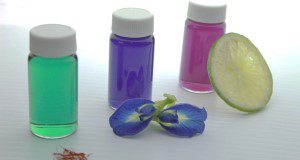Resumen
Butterfly pea (Clitoria ternatea), a twining vine native to Southeast Asia, produces deep blue to purple flowers that bloom nearly year-round in ideal conditions. When extracted in a liquid, the addition of a mild acid such as lemon or lime juice turns the naturally deep blue to purple color into a much lighter pink or purple color, giving the extract its color-changing ability. This new 5-page publication of the UF/IFAS Environmental Horticulture Department outlines the use of butterfly pea flower extract (BPFE) as a pH-dependent natural colorant, including an explanation of the science behind the color change, detailed parameters for flower extraction, instructions for storage and processing of the extract as well as a discussion of some of the other benefits of using BPFE.
http://edis.ifas.ufl.edu/ep573
Citas
Bryson, C. T., and M. S. DeFelice. 2009. Weeds of the South. University of Georgia Press. 467 p.
Chase, C. A., T. R. Sinclair, and S. J. Locascio. 1999. "Effects of soil temperature and tuber depth on Cyperus spp. control." WeedSci. 47: 467-472. https://doi.org/10.1017/S0043174500092092
Derr, J. F., and B. L. Appleton. 1989. "Weed control with landscape fabrics." J. Environ. Hort. 7: 129-133.
Westbrook, R.G. 1998. "Invasive plants: changing the landscape of America." https://digitalcommons.usu.edu/govdocs/490.
Govaerts, R., and D. A. Simpson. 2007. World checklist of Cyperaceae. Kew Pub. Royal Botanic Gardens. 780 p.
Holm, L. G., D. L. Plucknett, J. V. Pancho, and J. P. Herberger. 1977. The world's worst weeds. University Press. 609.
Hauser, E. W. 1962. "Development of purple nutsedge under field conditions." Weeds. 10: 315-321. https://doi.org/10.2307/4040836
Horowitz, M. 1972. "Growth, tuber formation and spread of Cyperus rotundus L. from a single tuber." Weed Res. 12: 348-363.
https://doi.org/10.1111/j.1365-3180.1972.tb01229.x
Parsons, W. T., and E. G. Cuthbertson. 1992. Noxious weeds of Australia. Melbourne, Australia: Inkata Press. 698.
Patton, A. and D. Weisenberger. 2017. "Sedge control for turf professionals." https://www.extension.purdue.edu/extmedia/ay/ay-338-w.pdf
Sholedice, F., and M. Renz. 2006. "Yellow and purple nutsedge: ornamental and turf guide." http://aces.nmsu.edu/ces/plantclinic/documents/nutsedges-w-12.pdf
Southern Weed Science Society (SWSS). 1995. Weeds of the United States. Compact disk for Windows® 3.1 or Windows® 95 or higher. 1508 W. University Avenue, Champaign, Illinois.
Tumbleson, M. E. and T. Kommedahl. 1961. "Reproductive potential of Cyperus esculentus by tubers." Weeds. 9: 646-653.
https://doi.org/10.2307/4040817
United States Department of Agriculture-Natural Resources Conservation Service (USDA-NRCS). 2017. "Plant Guide." https://plants.usda.gov/plantguide/pdf/pg_cyro.pdf
Wilen, C. A. 2010. "Pest notes: Nutsedge." University of California Statewide Integrated Pest Management Program. http://www.ipm.ucdavis.edu/PMG/PESTNOTES/pn 7432.html
Wills, D. G. 1998. "Comparison of purple nutsedge (Cyperus rotundus) from around the world." Weed Tech. 12: 491-503.https://doi.org/10.1017/S0890037X00044201
Unless otherwise specified, articles published in the EDIS journal after January 1, 2024 are licensed under a Creative Commons Attribution-NonCommercial-NoDerivs 4.0 International (CC BY-NC-ND 4.0) license.

